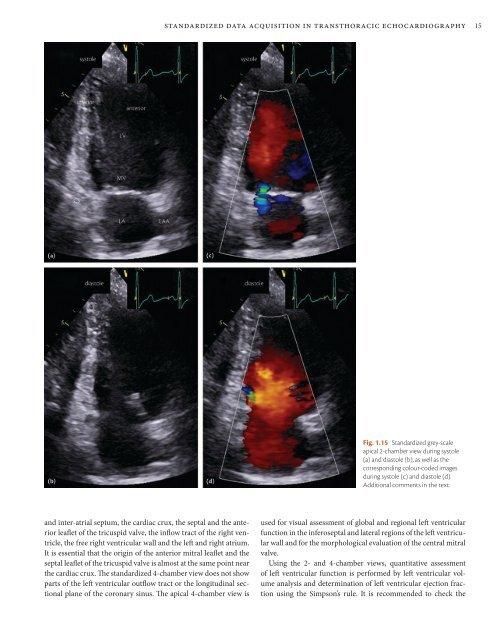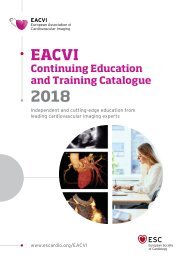ESC Textbook of Cardiovascular Imaging - sample
Discover the ESC Textbook of Cardiovascular Imaging 2nd edition
Discover the ESC Textbook of Cardiovascular Imaging 2nd edition
You also want an ePaper? Increase the reach of your titles
YUMPU automatically turns print PDFs into web optimized ePapers that Google loves.
standardized data acquisition in transthoracic echocardiography 15<br />
Fig. 1.15 Standardized grey-scale<br />
apical 2-chamber view during systole<br />
(a) and diastole (b), as well as the<br />
corresponding colour-coded images<br />
during systole (c) and diastole (d).<br />
Additional comments in the text.<br />
and inter-atrial septum, the cardiac crux, the septal and the anterior<br />
leaflet <strong>of</strong> the tricuspid valve, the inflow tract <strong>of</strong> the right ventricle,<br />
the free right ventricular wall and the left and right atrium.<br />
It is essential that the origin <strong>of</strong> the anterior mitral leaflet and the<br />
septal leaflet <strong>of</strong> the tricuspid valve is almost at the same point near<br />
the cardiac crux. The standardized 4-chamber view does not show<br />
parts <strong>of</strong> the left ventricular outflow tract or the longitudinal sectional<br />
plane <strong>of</strong> the coronary sinus. The apical 4-chamber view is<br />
used for visual assessment <strong>of</strong> global and regional left ventricular<br />
function in the inferoseptal and lateral regions <strong>of</strong> the left ventricular<br />
wall and for the morphological evaluation <strong>of</strong> the central mitral<br />
valve.<br />
Using the 2- and 4-chamber views, quantitative assessment<br />
<strong>of</strong> left ventricular function is performed by left ventricular volume<br />
analysis and determination <strong>of</strong> left ventricular ejection fraction<br />
using the Simpson’s rule. It is recommended to check the





